Page 33 of 268
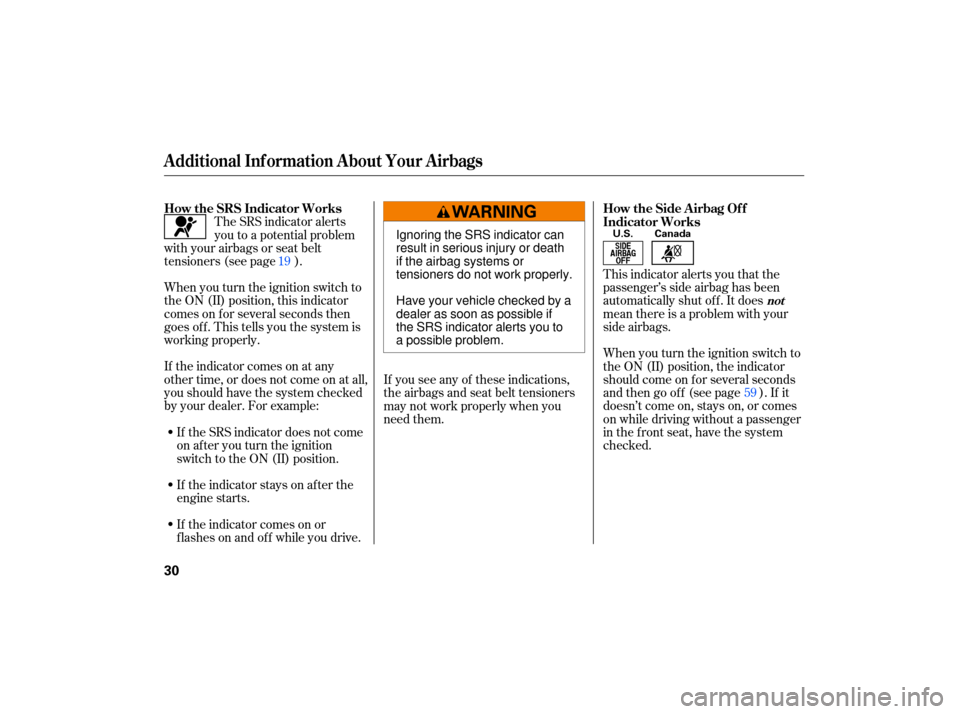
If the indicator comes on at any
other time, or does not come on at all,
you should have the system checked
by your dealer. For example: This
indicator alerts you that the
passenger’s side airbag has been
automatically shut off. It does
mean there is a problem with your
side airbags.
Wh
en you turn the ignition switch to
the ON (II) position, this indicator
comes on for several seconds then
goes off. This tells you the system is
working properly.
When you turn the ignition switch to
the ON (II) position, the indicator
should come on for several seconds
andthengooff(seepage ).Ifit
doesn’t come on, stays on, or comes
on while driving without a passenger
in the front seat, have the system
checked.
If
you see any of these indications,
the airbags and seat belt tensioners
may not work properly when you
need them.
The
SRS indicator alerts
you to a poten tial problem
with your airbags or seat belt
tensioners (see page ).
If the indicator comes on or
flashesonandoff whileyoudrive. If the indicator stays on after the
engine starts. If the SRS indicator does not come
on after you turn the ignition
switch to the ON (II) position. 59
19
How the SRS Indicator Works How the Side A irbag Of f
Indicator Works
Additional Inf ormation About Your Airbags
not
30
U.S. CanadaIgnoring the SRS indicator can
result in serious injury or death
if the airbag systems or
tensioners do not work properly.
Have your vehicle checked by a
dealer as soon as possible if
the SRS indicator alerts you to
a possible problem.
Page 34 of 268
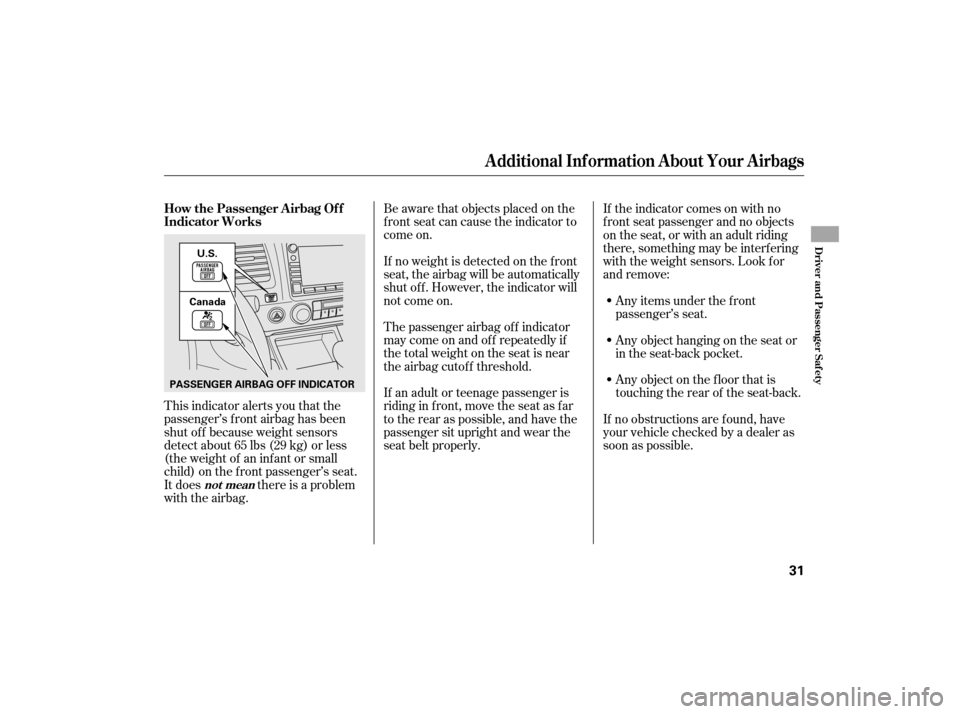
This indicator alerts you that the
passenger’s f ront airbag has been
shut of f because weight sensors
detect about 65 lbs (29 kg) or less
(the weight of an inf ant or small
child) on the f ront passenger’s seat.
It does there is a problem
with the airbag.Be aware that objects placed on the
f ront seat can cause the indicator to
come on.
If no weight is detected on the f ront
seat, the airbag will be automatically
shut of f . However, the indicator will
not come on.
The passenger airbag of f indicator
maycomeonandoff repeatedlyif
the total weight on the seat is near
the airbag cutof f threshold.
If an adult or teenage passenger is
riding in f ront, move the seat as f ar
to the rear as possible, and have the
passenger sit upright and wear the
seat belt properly.
If the indicator comes on with no
f ront seat passenger and no objects
on the seat, or with an adult riding
there, something may be interf ering
with the weight sensors. Look f or
and remove:
Any items under the f ront
passenger’s seat.
Any object hanging on the seat or
in the seat-back pocket.
Any object on the f loor that is
touching the rear of the seat-back.
If no obstructions are found, have
your vehicle checked by a dealer as
soon as possible.
Additional Inf ormation About Your Airbags
How the Passenger Airbag Of f
Indicator Works
not mean
Driver and Passenger Saf ety
31
PASSENGER AIRBAG OFF INDICATOR Canada
U.S.
Page 35 of 268
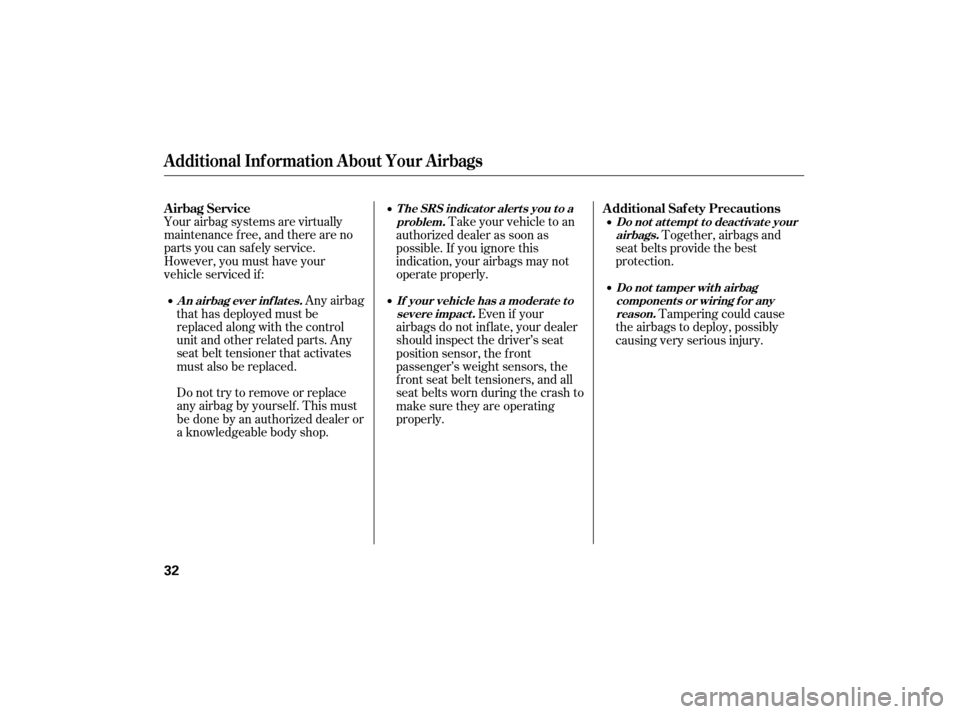
Your airbag systems are virtually
maintenance f ree, and there are no
parts you can saf ely service.
However, you must have your
vehicle serviced if:Any airbag
that has deployed must be
replaced along with the control
unit and other related parts. Any
seat belt tensioner that activates
must also be replaced.
Do not try to remove or replace
anyairbagbyyourself.Thismust
be done by an authorized dealer or
a knowledgeable body shop. Take your vehicle to an
authorized dealer as soon as
possible. If you ignore this
indication, your airbags may not
operate properly.
Even if your
airbags do not inflate, your dealer
should inspect the driver’s seat
position sensor, the f ront
passenger’s weight sensors, the
f ront seat belt tensioners, and all
seat belts worn during the crash to
make sure they are operating
properly. Together, airbags and
seat belts provide the best
protection.
Tampering could cause
the airbags to deploy, possibly
causing very serious injury.
Airbag Service Additional Saf ety Precautions
An airbag ever inf lates.
T he SRS indicat or alert s you t o a
problem.
If your vehicle has a moderat e t osevere impact . Donotattempttodeactivateyour
airbags.
Do not t amper wit h airbagcomponent s or wiring f or anyreason.
Additional Inf ormation About Your Airbags
32
Page 36 of 268
Improperly replacing
or covering f ront seat-back covers
can prevent your side airbags f rom
inf lating during a side impact.
This could make the
driver’s seat position sensor or the
f ront passenger’s weight sensors
inef f ective. If it is necessary to
remove or modif y a f ront seat to
accommodate a person with
disabilities, f irst contact Honda
Automobile Customer Service at
(800) 999-1009. If water or
another liquid soaks into a seat-
back, it can prevent the side airbag
cutoff system from working
properly.
Do not cover or replace f ront seat -
back covers wit hout consult ingyour dealer.
Do not remove or modif y a f ront
seat without consulting yourdealer. Do not expose the f ront passenger’s
seat-back to liquid.
Additional Inf ormation About Your Airbags
Driver and Passenger Saf ety
33
Page 37 of 268
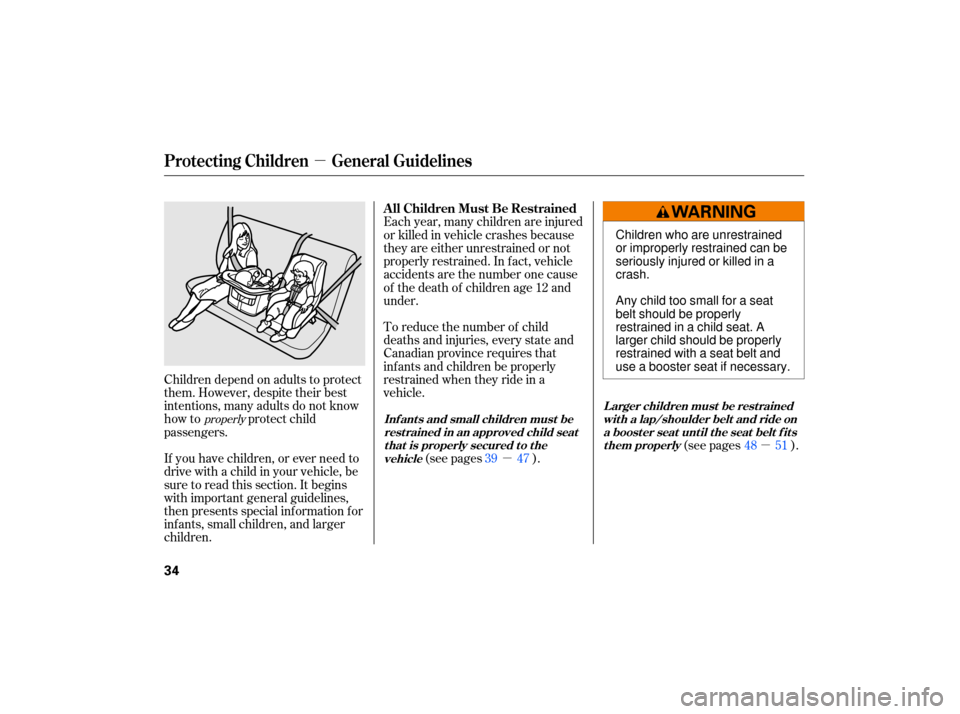
�µ
�µ
�µ
Children depend on adults to protect
them. However, despite their best
intentions, many adults do not know
how to protect child
passengers.
If you have children, or ever need to
drive with a child in your vehicl e, be
sure to read this section. It begins
with important general guidelines,
then presents special information for
infa nts, small children, and larger
children. To
reduce the number of child
deaths and injuries, every state and
Canadian province requires that
infants and children be properly
restrained when they ride in a
vehicle.
(see pages ).
(see pages ).
Each year, many children are injured
or killed in vehicle crashes because
they are either unrestrained or not
properly restrained. In f act, vehicle
accidents are the number one cause
of the death of children age 12 and
under.
39 47 5148
properly
All Children Must Be Restrained
Larger children must be restrained
wit h a lap/shoulder belt and ride ona boost er seat unt il t he seat belt f it st hem properly
Inf ant s and small children must be
rest rained in an approved child seatt hat is properly secured t o t hevehicle
Protecting Children General Guidelines
34
Children who are unrestrained
or improperly restrained can be
seriously injured or killed in a
crash.
Any child too small for a seat
belt should be properly
restrained in a child seat. A
larger child should be properly
restrained with a seat belt and
use a booster seat if necessary.
Page 38 of 268
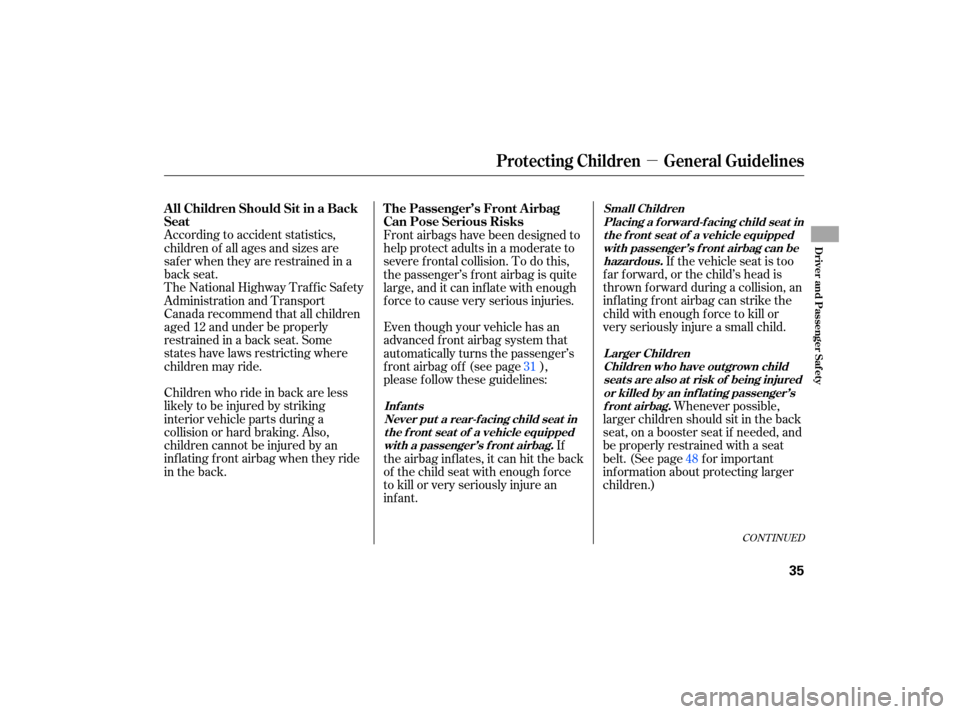
�µ
If the vehicle seat is too
farforward,orthechild’sheadis
thro wn forward during a collision, an
inflating front airbag can strike the
child with enough force to kill or
very seriously injure a small child.
According
to accident statistics,
children of all ages and sizes are
safer when they are restrained in a
back seat.
The National Highway Traffic Safety
Administration and Transport
Canada recommend that all children
aged 12 and under be properly
restrained in a back seat. Some
states have laws restricting where
children may ride.
Children who ride in back are less
likely to be injured by striking
interior vehicle parts during a
collision or hard braking. Also,
children cannot be injured by an
inflating front airbag when they ride
in the back. Even
though your vehicle has an
advanced front airbag system that
automatically turns the passenger’s
front airbag off (see page ),
please follow these guidelines:
If
the airbag inflates, it can hit the back
of the child seat with enough force
to kill or very seriously injure an
infant. Whenever
possible,
larger children should sit in the back
seat, on a booster seat if needed, and
be properly restrained with a seat
belt. (See page f or important
inf ormation about protecting larger
children.)
Front airbags have been designed to
help protect adults in a moderate to
severe f rontal collision. To do this,
the passenger’s f ront airbag is quite
large, and it can inflate with enough
f orce to cause very serious injuries.
31
48
CONT INUED
Placing a f orward-f acing child seat inthe f ront seat of a vehicle equippedwith passenger’s f ront airbag can behazardous.
Never put a rear-f acing child seat in the f ront seat of a vehicle equippedwit h a passenger’s f ront airbag. Small Children
Larger Children
Inf ant s Children who have outgrown child
seat s are also at risk of being injuredor killed by an inf lat ing passenger’sfront airbag.
All Children Should Sit in a Back
Seat The Passenger’s Front Airbag
Can Pose Serious Risks
Protecting Children General Guidelines
Driver and Passenger Saf ety
35
Page 39 of 268
�µ
To remind you of the passenger’s
f ront airbag hazards, and that
children must be properly restrained
in a back seat, your vehicle has
warninglabelsonthedashboard
(U.S. models) and on the f ront visors.
Please read and follow the
instructions on these labels.
Canadian Models
U.S. Models
Protecting Children General Guidelines
36
SUN VISORS
DASHBOARD
SUN VISORS
Page 40 of 268
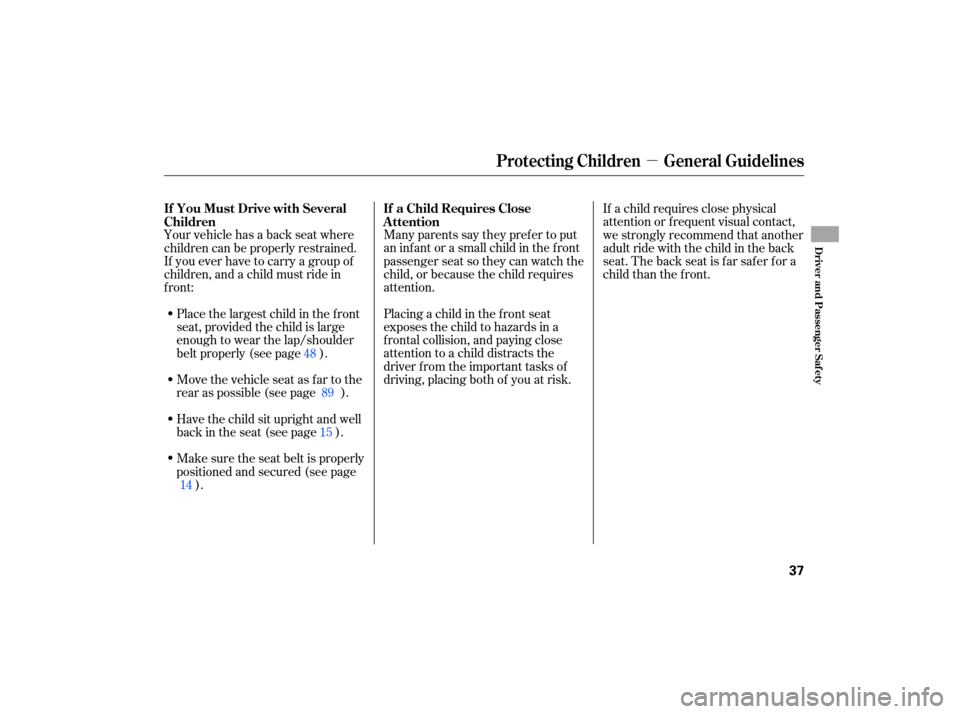
�µ
Many parents say they prefer to put
an infant or a small child in the front
passenger seat so they can watch the
child, or because the child requires
attention.
Placing a child in the front seat
exposes the child to hazards in a
frontal collision, and paying close
attention to a child distracts the
driver from the important tasks of
driving, placing both of you at risk.
Your
vehicle has a back seat where
children can be properly restrained.
If you ever have to carry a group of
children, and a child must ride in
front:
Place the largest child in the front
seat, pro vided the child is large
enough to wear the lap/shoulder
belt properly (see page ).
Move the vehicle seat as far to the
rear as possible (see page ).
Have the child sit upright and well
backintheseat(seepage ).
Make sure the seat belt is properly
positioned and secu red (see page
). If a child requires close physical
attention or frequent visual contact,
we strongly recommend that another
adult ride with the child in the back
seat. The back seat is far safer for a
child than the front.
15
14 48
89
If You Must Drive with Several
Children
If a Child Requires Close
Attention
Protecting Children General Guidelines
Driver and Passenger Saf ety
37